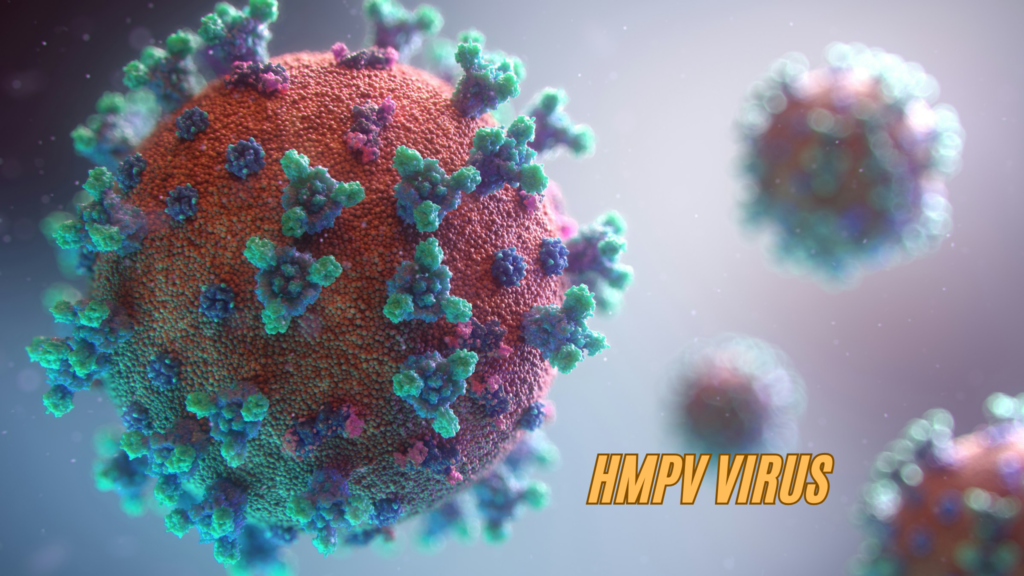
HMPV Virus: Have you been feeling under the weather lately? 🤒 If you’re experiencing flu-like symptoms that just won’t quit, you might be dealing with more than just a common cold. Enter the Human Metapneumovirus (HMPV) – a respiratory virus that’s been making headlines and causing concern among health professionals.
While HMPV may not be as well-known as its cousins, the flu or COVID-19, it’s been silently circulating for years, affecting millions worldwide. This stealthy virus can hit anyone, but it’s particularly dangerous for young children, older adults, and those with weakened immune systems. With symptoms that mimic other respiratory illnesses, HMPV often flies under the radar, leaving many people wondering why they’re not getting better.
In this comprehensive guide, we’ll delve into the world of HMPV, uncovering its symptoms, how it spreads, and most importantly, what you can do to protect yourself and your loved ones. From recognizing the early warning signs to understanding the latest treatment options, we’ve got you covered. So, let’s take a deep breath and explore everything you need to know about the HMPV virus, starting with an overview of this sneaky respiratory invader. 👇
Overview
What is Human Metapneumovirus (HMPV Virus)?
Human metapneumovirus (HMPV) is a respiratory virus that belongs to the Pneumoviridae family. Discovered in 2001, HMPV has quickly become recognized as a significant cause of respiratory infections worldwide. This virus primarily affects the upper and lower respiratory tracts, causing a range of symptoms from mild cold-like illness to severe pneumonia.
HMPV shares several characteristics with other common respiratory viruses:
- Seasonality: Peaks during late winter to early spring
- Age groups affected: All ages, but particularly young children and older adults
- Transmission: Spread through respiratory droplets and close contact
Key facts about HMPV:
- Prevalence: Affects 5-10% of children with respiratory infections annually
- Incubation period: 3-6 days
- Symptoms duration: Usually 7-10 days
| Characteristic | HMPV | RSV |
|---|---|---|
| Family | Pneumoviridae | Pneumoviridae |
| Discovery | 2001 | 1956 |
| Primary affected group | Children < 5 years | Infants < 1 year |
| Peak season | Late winter to spring | Fall to spring |
Understanding HMPV is crucial for healthcare providers and the general public to effectively diagnose, treat, and prevent respiratory infections. As we delve deeper into the symptoms and causes of HMPV, it’s important to recognize how this virus compares to other common respiratory pathogens.
Symptoms and Causes
What are the symptoms of human metapneumovirus?
Human metapneumovirus (HMPV) can cause a range of respiratory symptoms, varying from mild to severe. Common symptoms include:
- Cough (often persistent and dry)
- Fever
- Nasal congestion
- Shortness of breath
- Wheezing
- Sore throat
- Fatigue
In more severe cases, especially in high-risk groups, symptoms may progress to:
- Difficulty breathing
- Chest pain
- Rapid breathing
- Bluish tint to skin (cyanosis)
| Symptom Severity | Common Symptoms | Severe Symptoms |
|---|---|---|
| Mild to Moderate | Cough, fever, nasal congestion | N/A |
| Severe | All mild symptoms plus shortness of breath, wheezing | Difficulty breathing, chest pain, cyanosis |
What causes a human metapneumovirus infection?
HMPV is caused by a virus belonging to the Pneumoviridae family. Transmission occurs through:
- Respiratory droplets from coughs or sneezes
- Close contact with infected individuals
- Touching contaminated surfaces and then touching your face
The virus is highly contagious and can spread rapidly in communities, particularly in closed settings like schools, daycares, and nursing homes.
What are the complications of human metapneumovirus?
While most HMPV infections resolve on their own, some individuals may develop complications:
- Pneumonia
- Bronchiolitis (in young children)
- Exacerbation of asthma or COPD
- Respiratory failure (in severe cases)
High-risk groups for complications include:
- Infants and young children
- Elderly individuals
- People with weakened immune systems
- Those with pre-existing respiratory conditions
Diagnosis and Tests
How is human metapneumovirus diagnosed?
Diagnosing human metapneumovirus (HMPV) can be challenging due to its similarity with other respiratory infections. Healthcare providers typically employ a combination of clinical assessment and laboratory tests to confirm an HMPV infection.
- Clinical Evaluation:
- Patient history
- Physical examination
- Assessment of symptoms
- Laboratory Tests:
- Polymerase Chain Reaction (PCR)
- Viral culture
- Immunofluorescence assays
| Test Type | Advantages | Disadvantages |
|---|---|---|
| PCR | Highly sensitive and specific | Expensive, requires specialized equipment |
| Viral culture | Can identify multiple viruses | Time-consuming (3-5 days for results) |
| Immunofluorescence | Rapid results (within hours) | Less sensitive than PCR |
PCR is the most commonly used and reliable method for HMPV diagnosis. It detects the virus’s genetic material in respiratory samples, such as nasal swabs or throat swabs. This test is highly sensitive and can provide results within 24-48 hours.
In some cases, healthcare providers may also order additional tests to rule out other respiratory infections or complications. These may include chest X-rays, blood tests, or tests for other viruses like influenza or respiratory syncytial virus (RSV).
Early and accurate diagnosis is crucial for appropriate treatment and management of HMPV infections, especially in high-risk groups such as young children, older adults, and individuals with weakened immune systems.
Management and Treatment
How is human metapneumovirus treated?
Human metapneumovirus (HMPV) treatment primarily focuses on managing symptoms and providing supportive care, as there is no specific antiviral medication available for this virus. The treatment approach varies depending on the severity of symptoms and the patient’s overall health condition.
Here’s a breakdown of common treatment strategies:
- Symptom management:
- Over-the-counter pain relievers
- Fever reducers
- Nasal decongestants
- Cough suppressants
- Hydration:
- Increased fluid intake
- Oral rehydration solutions
- Rest and recovery:
- Adequate sleep
- Reduced physical activity
- Oxygen therapy:
- For severe cases with breathing difficulties
- Hospital care:
- Intravenous fluids
- Respiratory support
| Severity | Treatment Approach |
|---|---|
| Mild | Home care, OTC medications |
| Moderate | Outpatient care, close monitoring |
| Severe | Hospitalization, intensive care |
It’s important to note that antibiotics are not effective against HMPV, as it is a viral infection. However, in cases of secondary bacterial infections, antibiotics may be prescribed. For high-risk patients, such as infants, elderly, or immunocompromised individuals, close medical supervision is crucial to prevent complications.
While research is ongoing, some studies suggest that ribavirin, an antiviral drug, may have potential in treating severe HMPV cases. However, its efficacy is still under investigation.
Prevention
Can you prevent a human metapneumovirus infection?
While it’s challenging to completely prevent HMPV infections, you can significantly reduce your risk by implementing several key strategies:
- Practice good hygiene:
- Wash hands frequently with soap and water
- Use alcohol-based hand sanitizers when soap is unavailable
- Avoid touching your face, especially eyes, nose, and mouth
- Maintain social distancing:
- Stay at least 6 feet away from people who are sick
- Avoid crowded places during peak respiratory virus seasons
- Boost your immune system:
- Get adequate sleep
- Eat a balanced diet rich in vitamins and minerals
- Exercise regularly
- Manage stress effectively
- Use personal protective equipment:
- Wear a mask in public spaces during outbreaks
- Consider wearing gloves in high-risk environments
- Clean and disinfect:
- Regularly clean frequently touched surfaces
- Use EPA-approved disinfectants effective against viruses
| Prevention Strategy | Effectiveness |
|---|---|
| Hand hygiene | High |
| Social distancing | High |
| Immune boosting | Moderate |
| PPE use | Moderate |
| Surface cleaning | Moderate |
By consistently applying these prevention methods, you can significantly reduce your risk of contracting HMPV and other respiratory infections. Remember, prevention is especially crucial for high-risk groups such as young children, older adults, and individuals with weakened immune systems.
Outlook / Prognosis
How long does human metapneumovirus last?
Human metapneumovirus (HMPV) typically lasts for 5 to 14 days, with symptoms peaking around day 3 to 5. Recovery time can vary depending on the individual’s age and overall health. Here’s a breakdown of the typical HMPV timeline:
| Stage | Duration | Description |
|---|---|---|
| Incubation | 3-6 days | Virus present but no symptoms |
| Onset | 1-2 days | Mild symptoms appear |
| Peak | 3-5 days | Symptoms at their worst |
| Recovery | 5-7 days | Gradual improvement |
How do I take care of myself?
To manage HMPV symptoms and promote recovery:
- Rest as much as possible
- Stay hydrated by drinking plenty of fluids
- Use over-the-counter pain relievers for fever and discomfort
- Use a humidifier to ease respiratory symptoms
- Avoid smoking and secondhand smoke
When should I see my healthcare provider?
Seek medical attention if you experience:
- Difficulty breathing or shortness of breath
- High fever that persists or worsens
- Symptoms that don’t improve after a week
- Severe fatigue or inability to stay hydrated
What questions should I ask my doctor?
When discussing HMPV with your healthcare provider, consider asking:
- Are there any specific treatments for my case of HMPV?
- How can I prevent spreading the virus to others?
- What warning signs should I watch for that indicate complications?
- When can I safely return to work or school?
- Are there any long-term effects of HMPV I should be aware of?
Understanding these aspects of HMPV can help you manage the infection effectively and know when to seek additional medical care. While most cases resolve on their own, being informed about the prognosis and self-care measures is crucial for a smooth recovery.

The Human Metapneumovirus (HMPV) is a respiratory illness that can affect people of all ages, but particularly impacts young children, older adults, and those with weakened immune systems. Recognizing its symptoms, understanding how it spreads, and knowing the available treatment options are crucial for managing this viral infection effectively. While HMPV can cause severe respiratory issues in some cases, most people recover with supportive care and rest.
Prevention remains the best defense against HMPV. By practicing good hygiene habits, such as frequent handwashing, avoiding close contact with infected individuals, and maintaining a clean environment, we can significantly reduce the risk of contracting and spreading the virus. As research continues to advance our understanding of HMPV, staying informed and following recommended guidelines will help protect ourselves and our communities from this respiratory illness.
Explore Our Recipes


